The past year has been a great year for science with major advances in several areas. Too many exciting results to mention here. Instead, to reflect about the past year I have chosen a representative paper for each month of the year that I hope can serve as an example of the great science going on in a number of research fields. Of course, this is a highly subjective and personal collection, and indeed there might be others worth mentioning. But the aim was also to provide a balanced overview of the year that covers a variety of topics.
Of course, if you have an exciting paper to add, please feel free to use the comments section below to let us know!
Anyway, enough said, here are some of my highlights from the past year:

Simulations of electronic excitations in an iron-based superconductor. Image by Oak Ridge National Laboratory via flickr.
JANUARY – iron-based superconductors
Since they were discovered in 2008, iron-based superconductors, the pnictides, have been one of the hottest topics in condensed matter physics. Part of their appeal stems from the fact that they are based on iron, which is a magnetic element. Normally, magnets and superconductivity exclude each other.
The iron-based compounds have a similar crystal structure as the so-called cuprates, which are the materials with the highest superconducting temperatures known. The mechanism for these high-temperature superconductors is unknown, and studying the iron-based superconductors may also be relevant to the understanding of the cuprates.
This paper published in Science shows for the first time that the electrons in the iron-based superconductors show a periodic arrangement that is different to the periodicity of the atoms in the crystal. Similar observations have been made in the cuprates, and their understanding is considered important to the mechanism of high-temperature superconductivity.
Chuang, T., Allan, M., Lee, J., Xie, Y., Ni, N., Bud’ko, S., Boebinger, G., Canfield, P., & Davis, J. (2010). Nematic Electronic Structure in the “Parent” State of the Iron-Based Superconductor Ca(Fe1-xCox)2As2 Science, 327 (5962), 181-184 DOI: 10.1126/science.1181083

Schematic of the device where a nanowire acts as gate for a graphene transistor. (c) 2010 Nature Publishing Group
FEBRUARY – graphene
This year, the Nobel prize in physics that was awarded for discoveries in graphene – those atomically thin layers of carbon. One of the promises of graphene are applications in electronics, where the fast movement of electrons in the material can be used for ultrasmall and very fast transistors. Just how fast these transistors can go was demonstrated by Phaedon Avouris and colleagues from IBM in this Science paper, where they reported speeds up to 100 GHz. These transistors are made by a conventional fabrication process that is scalable to a large number of devices.
Later in the year another group reported graphene transistors in Nature that reach speeds up to 300 GHz, although with what I believe is a far less scalable approach. In a publication by the same people parallel to their Nature paper (and thus contrary to Nature‘s editorial policy), they even claim speeds up to 1,400 GHz.
Lin, Y., Dimitrakopoulos, C., Jenkins, K., Farmer, D., Chiu, H., Grill, A., & Avouris, P. (2010). 100-GHz Transistors from Wafer-Scale Epitaxial Graphene Science, 327 (5966), 662-662 DOI: 10.1126/science.1184289
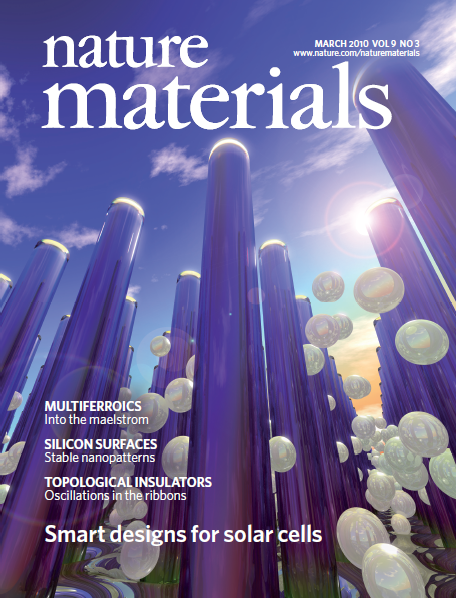
Nanowire solar cells. (c) Nature Materials March 2010
MARCH – new solar cell designs
Materials that enable the use of renewable energy continue to be a key research area. This is exemplified by a paper from the group of Harry Atwater that presents a new device architecture for solar cells. It has been known that solar cells based on nanowires instead of thin films use much less material while some of the designs almost retain the same energy conversion efficiencies as thin films.
Here, Atwater and colleagues optimized the interaction between light and the silicon nanowires. They poured reflecting nanoparticles between the nanowires so that light gets bounced off between the nanowires more often and has a better chance of getting absorbed. This kind of sophisticated interaction between light and matter is increasingly used to enhance the efficiency of solar cells.
Kelzenberg, M., Boettcher, S., Petykiewicz, J., Turner-Evans, D., Putnam, M., Warren, E., Spurgeon, J., Briggs, R., Lewis, N., & Atwater, H. (2010). Enhanced absorption and carrier collection in Si wire arrays for photovoltaic applications Nature Materials DOI: 10.1038/nmat2635
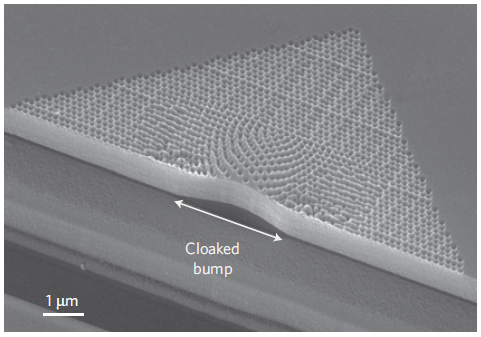
An invisibility "carpet" cloak that hides an object underneath the bump. This cloak operates at 3.8 micrometers wavelength. Reprinted by permission from Macmillan Publishers Ltd. Nature Materials 8, 568-571 (29 April 2009)
APRIL – invisibility cloaks
Metamaterials are artificial structures that offer the unprecedented possibility to clontrol the propagation of light. An example are cloaking devices that render objects invisible, although all such devices demonstrated so far work at infrared wavelengths or beyond. This paper from the group of Martin Wegener in Science reports cloaking at wavelengths down to 1.4 micrometers, which is the closest yet we have come to the visible region. They have made a ‘carpet’ cloak, which is able to hide an object on a surface underneath the device.
As for visible light, the problem is that for these wavelengths shorter than infrared light metamaterials require very small features that are challenging to make. This makes the achievement by the Wegener group all the more remarkable.
However, one shouldn’t get too excited about the capabilities of such cloaks. As I warned previously, there is a lot of hype about cloaks, and complete invisibility looks pretty unlikely at this stage.
Ergin, T., Stenger, N., Brenner, P., Pendry, J., & Wegener, M. (2010). Three-Dimensional Invisibility Cloak at Optical Wavelengths Science, 328 (5976), 337-339 DOI: 10.1126/science.1186351
MAY – polymer solar cells
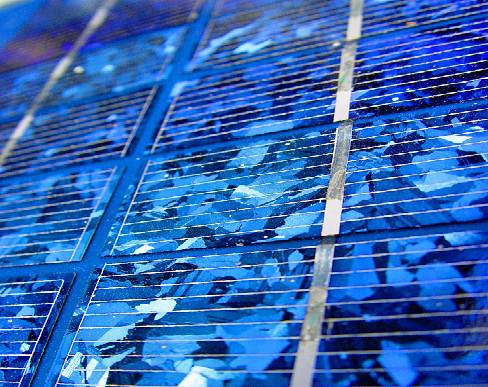
Photo by Scott Robinson (Clearly Ambiguous) via flickr.
Polymer-based solar cells offer a cost-efficient alternative to the expensive silicon ones. But this cost advantage comes at a price, their solar conversion efficiencies reaches only a few percentage points.
In this already well-cited work published in Advanced Materials, Luping Lu and colleagues systematically optimized polymer compositions to arrive at a record-beating 7.4% solar conversion efficiency. Their work shows the considerable potential of organic solar cells.
Liang, Y., Xu, Z., Xia, J., Tsai, S., Wu, Y., Li, G., Ray, C., & Yu, L. (2010). For the Bright Future-Bulk Heterojunction Polymer Solar Cells with Power Conversion Efficiency of 7.4% Advanced Materials, 22 (20) DOI: 10.1002/adma.200903528
JUNE – skyrmions on the rise
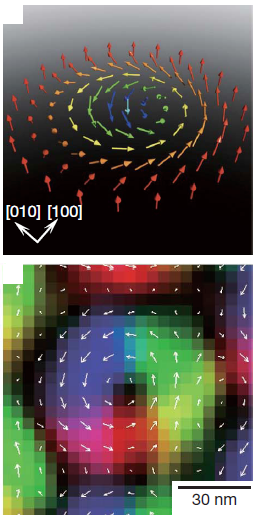
Skyrmions are complex arrangements of atomic magnets (top). They have now been imaged directly for the first time (bottom). (c) Nature 465, 901–904 (2010).
In a ferromagnet all the atomic magnetic moments are aligned parallel to each other. However, in some magnets, and only under certain experimental conditions, more complex arrangements of magnetic moments can form, so-called skyrmions. Skyrmions could be the basis for new electronic devices as their interaction with electric currents is different to ferromagnets.
The properties of skyrmions had been study previously, but the groups of Naoto Nagaosa and Yoshinori Tokura have achieved the first direct experimental imaging of skyrmions at the surface of the compound MnSi, albeit at the rather low temperatures typical for the study of skyrmions at the time.
Later in the year Tokura and colleagues then also for the first time have been able to observe skyrmions close to room-temperature and for a much broader range of experimental conditions. This discovery in thin films of the alloy FeGe clearly establishes the possibility for applications.
Indeed, the practical implications of skyrmions have also become even clearer when it was demonstrated that an electrical current can rather easily switch the magnetic orientation of skyrmions. Skyrmions are on the rise!
Yu, X., Onose, Y., Kanazawa, N., Park, J., Han, J., Matsui, Y., Nagaosa, N., & Tokura, Y. (2010). Real-space observation of a two-dimensional skyrmion crystal Nature, 465 (7300), 901-904 DOI: 10.1038/nature09124
JULY – topological insulators

A Möbius strip retains it topological properties even if deformed. The electronic properties of a topological insulator are similarly protected. Photo by David Benbennick via Wikimedia Commons.
Topological insulators have received an increasing attention as they promise electronic devices that operate with almost none of the electric losses that plague conventional electronics.
Although plenty of candidate topological insulators have been identified, measurements of electronic properties have been scarce, and none of these have shown too compelling features. Two papers from the July issue of Nature Materials present an entirely new class of candidate materials among which there are plenty of compounds that could be topological insulators.
Chadov, S., Qi, X., Kübler, J., Fecher, G., Felser, C., & Zhang, S. (2010). Tunable multifunctional topological insulators in ternary Heusler compounds Nature Materials, 9 (7), 541-545 DOI: 10.1038/nmat2770
Lin, H., Wray, L., Xia, Y., Xu, S., Jia, S., Cava, R., Bansil, A., & Hasan, M. (2010). Half-Heusler ternary compounds as new multifunctional experimental platforms for topological quantum phenomena Nature Materials, 9 (7), 546-549 DOI: 10.1038/nmat2771
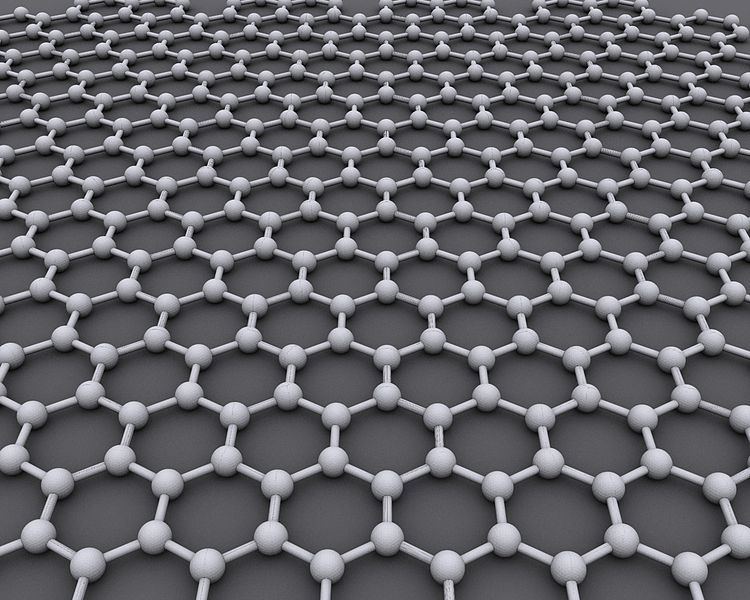
A model of graphene. Image by AlexanderAlUS via Wikimedia Commons.
AUGUST – graphene
Graphene again? Well there is a reason this topic deserved a Nobel prize! One of the problems for practical applications had been the large-scale production of graphene sheets. This fabrication problem has now been solved impressively by Sumio Iijima and colleagues, who demonstrated a large-scale roll-to-roll fabrication of graphene films. Applications of such films include touch screen monitors, where graphene could be used as a transparent electrode.
Bae, S., Kim, H., Lee, Y., Xu, X., Park, J., Zheng, Y., Balakrishnan, J., Lei, T., Ri Kim, H., Song, Y., Kim, Y., Kim, K., Özyilmaz, B., Ahn, J., Hong, B., & Iijima, S. (2010). Roll-to-roll production of 30-inch graphene films for transparent electrodes Nature Nanotechnology, 5 (8), 574-578 DOI: 10.1038/nnano.2010.132
SEPTEMBER – two 50 year anniversaries!
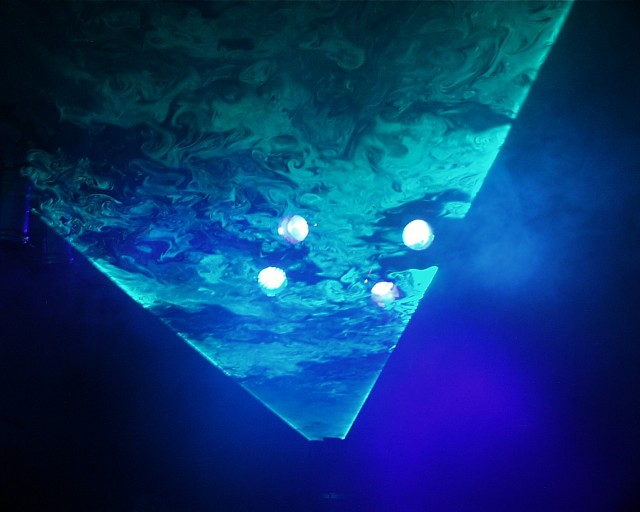
Image by Gmaxwell via wikimedia commons.
I use this month to commemorate two 50 year anniversaries that occurred in 2010. The first one is the first demonstration of the laser by Theodore Maiman on 16 May 1960. The importance of the laser on our daily life hardly needs emphasizing. An editorial that I wrote for Nature Materials provides more details (free access to registered users of the nature.com website). In the same issue I interviewed one of the pioneers of the laser, Charles Townes, although that text sadly is behind the paywall.
The other anniversary, which was celebrated in September, is the first realization of a metallic glass. As I commented earlier, although metallic glasses haven’t reached the commercial significance of lasers, they are strong materials that hold considerable potential for structural applications and at the same time are interesting for their fundamental properties.
MAIMAN, T. (1960). Stimulated Optical Radiation in Ruby Nature, 187 (4736), 493-494 DOI: 10.1038/187493a0
KLEMENT, W., WILLENS, R., & DUWEZ, P. (1960). Non-crystalline Structure in Solidified Gold–Silicon Alloys Nature, 187 (4740), 869-870 DOI: 10.1038/187869b0

Stretchable electronic arrays. The LED sheets can be twisted by 720 degrees and considerably stretched. The wavy metal wires are visible in the image on the on the right. Reprinted by permission from Macmillan Publishers Ltd. Nature Materials (2010). doi:10.1038/nmat2879
OCTOBER – stretchable electronics
Stretchable electronics has a large potential for applications that range from solar cells to bioimplants. John Rogers and colleagues are one of the pioneers in this area. In this work, they make ‘LED tattoos’, tiny light-emitting diodes and photodetectors embedded into a stretchable substrate that could be implanted under the skin for diagnostic purposes. Other uses of stretchable electronic devices include implants to monitor heart or brain activity.
I also like to point out another great paper published in October, the demonstration of extremely fast electrons in an oxygen-based electronic device, which undoubtedly is a great achievement for that field.
Kim, R., Kim, D., Xiao, J., Kim, B., Park, S., Panilaitis, B., Ghaffari, R., Yao, J., Li, M., Liu, Z., Malyarchuk, V., Kim, D., Le, A., Nuzzo, R., Kaplan, D., Omenetto, F., Huang, Y., Kang, Z., & Rogers, J. (2010). Waterproof AlInGaP optoelectronics on stretchable substrates with applications in biomedicine and robotics Nature Materials, 9 (11), 929-937 DOI: 10.1038/nmat2879

Credit: Mabuchi Design Office / Yuki Akimoto
NOVEMBER – thermodynamics
Thermodynamics is not really the subject that the majority of physics students love. It deals in an averaged way with the properties of matter. But whatever your opinion on thermodynamics, you got to love this experiment published in Nature Physics.
There, researchers for the first time directly verify that energy is stored in information, and how this tiny bit of energy is used by small particles in an electric field. As these particles are successively moved upwards in an electric field, they gain energy from knowing their precise position, which is then used to propel them further up. This observation verifies a hypothesis that goes back to 1867.
If you like to find out more about this experiment, take a look at my blog post.
Toyabe, S., Sagawa, T., Ueda, M., Muneyuki, E., & Sano, M. (2010). Experimental demonstration of information-to-energy conversion and validation of the generalized Jarzynski equality Nature Physics, 6 (12), 988-992 DOI: 10.1038/nphys1821

Photo by Philippe Teuwen via wikimedia.
DECEMBER – spin electronics
December’s paper is one I just blogged about in my previous post. The topic of this study is on new ways of using the electron’s magnetic information, its spin, for electronic devices. One of the big challenges for the field is to realize the equivalent of the most fundamental electronic logic device, the transistor, by using only the electron’s spin.
In this Science paper, a close relative of the yet to be demonstrated spin transistor is reported. It is a slightly more complex transistor structure based on the so-called spin Hall effect. Notably, this transistor operates entirely without the electrons moving, which is one of the aims of spin electronics as part of the strategy to avoid the losses associated with electric currents. In the spin Hall effect transistor the spin current can be switched on and off similar to the way a regular transistor controls electric current. This demonstration marks nicely the progress achieved in spin electronic devices.
Wunderlich, J., Park, B., Irvine, A., Zarbo, L., Rozkotova, E., Nemec, P., Novak, V., Sinova, J., & Jungwirth, T. (2010). Spin Hall Effect Transistor Science, 330 (6012), 1801-1804 DOI: 10.1126/science.1195816
 This post was chosen as an Editor’s Selection for ResearchBlogging.org
This post was chosen as an Editor’s Selection for ResearchBlogging.org


Trackbacks/Pingbacks
[…] This post was mentioned on Twitter by Joerg Heber, Psychology Feeds. Psychology Feeds said: 2010 – twelve months of great science: The past year has been a great year for science with major advances in se… http://bit.ly/htSdXw […]
[…] 2010 – Twelve months of great science. ‘Tis the season for contemplation and reminiscence, and at All That Matters Joerg Heber gives a month-by-month review of what was hot in physics and materials science in 2010. There’s graphene, solar cells, special anniversaries, skyrmions, cuprates and more. […]
RB Editor’s selections: Memories of 2010, Desert crocodiles, CAPTCHAs and shifty looks…
Tweet[cross-posted from the ResearchBlogging.org News blog.] Happy New Year to all the ResearchBlogging contributors and readers out there, I hope you all have a fab year full of love, joy and awesome science. I’m happy to kick off the year with …